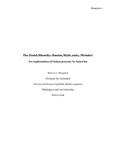The Model Minority: Mantra, Myth, and... Mistake?

View/
Author
Musgrave, Monica L.
Subject
Washington and Lee University, Shepherd Poverty Program
Model minority stereotype
Poverty
Performance standards
Mentally ill
Metadata
Show full item recordDescription
Capstone; [FULL-TEXT WILL BE AVAILABLE FOLLOWING A 5-YEAR EMBARGO] Monica L. Musgrave is a member of the Class of 2018 of Washington and Lee University. Since the 1960s, the Asian population in America has been eagerly penned the “model minority,” espousing the ideal of what each minority in America should aspire to be. This translates roughly to high educational achievement and attainment, higher socioeconomic status, stable and traditional family structure, low rates of crime, and a life dedicated to hard work. More bluntly put, the “model minority” stereotype glorifies the work of a minority group to grow nearer towards “Whiteness” and White values, sometimes referred to as “passing as/acting” White. What seems as a harmless, and even complimentary stereotype at first, however, can have a darker impact leering in the background, enforcing the pressure of exceedingly high expectations on those whom this moniker applies. In this paper, we will examine the history of the Asian population in America in determining both what led to this determination as a model minority and what exactly it constitutes. We will investigate its impacts on the Asian population of America, with a particular focus on when the model minority standard is not met through poverty.